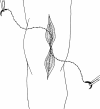Perioperative closure-related complication rates and cost analysis of barbed suture for closure in TKA
- PMID: 21952745
- PMCID: PMC3237999
- DOI: 10.1007/s11999-011-2104-7
Perioperative closure-related complication rates and cost analysis of barbed suture for closure in TKA
Abstract
Background: The use of barbed suture for surgical closure has been associated with lower operative times, equivalent wound complication rate, and comparable cosmesis scores in the plastic surgery literature. Similar studies would help determine whether this technology is associated with low complication rates and reduced operating times for orthopaedic closures.
Questions/purposes: We compared a running barbed suture with an interrupted standard suture technique for layered closure in primary TKA to determine if the barbed suture would be associated with (1) shorter estimated closure times; (2) lower cost; and (3) similar closure-related perioperative complication rates.
Methods: We retrospectively compared two-layered closure techniques in primary TKA with either barbed or knotted sutures. The barbed group consisted of 104 primary TKAs closed with running barbed suture. The standard group consisted of 87 primary TKAs closed with interrupted suture. Cost analysis was based on cost of suture and operating room time. Clinical records were assessed for closure-related complications within the 6-week perioperative period.
Results: Average estimated closure time was 2.3 minutes shorter with the use of barbed suture. The total closure cost was similar between the groups. The closure-related perioperative complication rates were similar between the groups.
Conclusions: Barbed suture is associated with a slightly shorter estimated closure time, although this small difference is of questionable clinical importance. With similar overall cost and no difference in perioperative complications in primary TKA, this closure methodology has led to more widespread use at our institution.
Figures
References
-
- Sharan DA, Genuario J, Mehta S, Kusuma S, Ranawat A, Nunley R, Weinstein SL. Current issues in health policy: a primer for the orthopaedic surgeon. J Am Acad Orthop Surg. 2007;15:76–86. - PubMed
Publication types
MeSH terms
LinkOut - more resources
Full Text Sources
Medical


